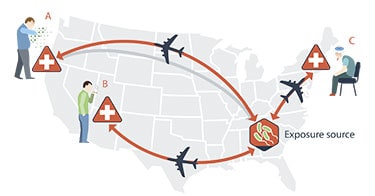How to Report Cases
Surveillance Systems
For travel-associated cases, email travellegionella@cdc.gov to let CDC know about travel-associated cases of legionellosis within 7 days of receiving a case report.
You can routinely submit one of the CDC legionellosis case report forms to SLDSS multiple ways (e.g., email, mail, FTP, fax).
Refer to CDC Legionellosis Case Reports: Forms and Instructions or email travellegionella@cdc.gov for more information.
Legionellosis (Legionnaires’ disease, Pontiac fever, and very rarely, disease due to Legionella infection at extrapulmonary sites) is a nationally notifiable disease. CDC monitors cases through two surveillance systems at the national level:
- National Notifiable Diseases Surveillance System (NNDSS)
- Supplemental Legionnaires’ Disease Surveillance System (SLDSS)
Public health officials should report outbreaks of Legionnaires’ disease and Pontiac fever through the Waterborne Disease Outbreak Surveillance System (WBDOSS) of the National Outbreak Reporting System (NORS).
CDC maintains SLDSS to collect extended information on legionellosis cases, such as exposure history and method of diagnosis, beyond the limited information CDC receives in NNDSS. CDC uses the additional information collected in SLDSS to
- Identify outbreaks in a timely manner
- Better understand the epidemiology of legionellosis
- Develop improved methods for prevention and response
CDC is working with partners to develop a more streamlined method of reporting that will be integrated with NNDSS. Until that new method is available, CDC will continue to use SLDSS.
Methods of Surveillance

Approximately 10–15% of people with Legionnaires’ disease will have traveled during their period of possible exposure.
- Public health officials should maintain an internal system for tracking and reviewing cases of legionellosis. They should use that system to identify epidemiologic links so they can perform timely investigations.
- Public health officials should report all cases of legionellosis to NNDSS. Methods for reporting cases to NNDSS, usually with basic demographic information, vary by health department. Learn more about cases of legionellosis reported to NNDSS.
- Public health officials should also report all cases of legionellosis to SLDSS, which allows for reporting of additional information, such as exposure to travel and healthcare facilities, as well as laboratory confirmation data. Public health officials can report cases to SLDSS using one of the CDC Legionellosis Case Report Forms or a state-specific case report form.
- Ideally, public health officials should report all cases to SLDSS within 30 days of receiving a case report.
- Travel-associated cases, however, should be reported within 7 days of receiving a case report.
- Because travel-associated cases often occur among residents of different states, it takes centralized reporting to link cases to a possible common source.
- Timely intervention relies on timely identification of outbreaks.
- Travel destination(s) (including accommodation or facility name[s] and address[es]) and dates of travel should be included in this report.
- For cases of legionellosis with out-of-state exposures, CDC will notify state health departments where the exposure took place within one business day of receiving the report from the patient’s state of residence.